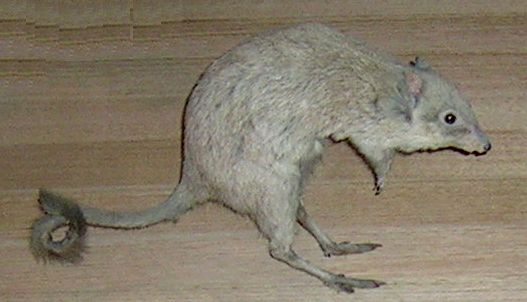- Potoroidae
Taxobox
name = PotoroidaeMSW3 Groves|pages=56-58]
fossil_range=Late Oligocene - Recent

image_caption =Woylie ("Bettongia penicillata")
regnum =Animal ia
phylum = Chordata
classis =Mammal ia
infraclassis =Marsupialia
ordo =Diprotodontia
subordo =Macropodiformes
familia = Potoroidae
familia_authority = Gray,1821
subdivision_ranks = Genera
subdivision = "Aepyprymnus "
"Bettongia "
†"Caloprymnus"
"Potorous "The
marsupial family Potoroidae includes thebettong s,potoroo s, and two of therat-kangaroo s. All are rabbit-sized, brown, jumping marsupials and resemble a largerodent or a very smallwallaby .Characteristics
The potoroids are smaller relatives of the
kangaroo s and wallabies, and may be ancestral to that group. In particular, the teeth show a simpler pattern than in the kangaroo family, with longer upperincisor s, larger canines, and four cusps on the molars. cite book |editor=Macdonald, D.|author= Poole, William E.|year=1984 |title= The Encyclopedia of Mammals|publisher= Facts on File|location=New York|pages= 862-871|isbn= 0-87196-871-1] However, both groups possess a wide diastema between the incisors and the cheek teeth, and the potoroids have a similar dental formula to their larger relatives:dentition|3.0-1.2.4|1.0.2.4In most respects, however, the potoroids are similar to small wallabies. Their hind feet are elongated, and they move by hopping, although the adaptations are not as extreme as they are in true wallabies, and, like
rabbit s, they often use their forelimbs to move about at slower speeds.The potoroids are, like nearly all diprotodonts,
herbivorous . However, while they take a wide variety of vegetable foods, most have a particular taste for the fruiting bodies offungi , and often depend on fungi to see them through periods when there is little else to eat in the dry Australian bush. One example of a potoroo that sustains itself on fungi is theLong-footed Potoroo . This animal's diet is almost entirely made up of fungal spores. This limits its habitat range as it needs to live in a moist environment, with dense cover to reduce predation from introduced species such as foxes and feral cats.tatus
There are four species of bettong. Bettongs were endangered because settlers took much of their habitat and the foxes they introduced to the island also killed many of them. At one time, both species lived all over Australia. But today, the Tasmanian Bettong lives only in the eastern half of
Tasmania , and the Northern Bettong lives only in three isolated populations in northernQueensland .Classification
There are three extant genera of potoroid, containing eight species: [cite web | author = Haaramo, M. | title = Mikko's Phylogeny Archive: Potoroidae - rat-kenguroos | date =
2005-11-15 | accessdate = 2008-01-27 | url = http://www.fmnh.helsinki.fi/users/haaramo/Metazoa/Deuterostoma/Chordata/Synapsida/Metatheria/Notometatheria/Diprotodontia/Potoroidae.htm]* Family Potoroidae
** Genus †"Wakiewakie "
** Genus †"Purtia "
** Genus ?†"Palaeopotorous "
** Subfamily †Bulungamayinae
*** Genus †"Wabularoo "
**** †"Wabularoo hilarus "
**** †"Wabularoo naughtoni "
*** Genus †"Bulungamaya "
** SubfamilyPotoroinae
*** Genus "Aepyprymnus "
****Rufous Rat-kangaroo , "Aepyprymnus rufescens"
*** Genus "Bettongia "
****Eastern Bettong , "Bettongia gaimardi"
****Boodie , "Bettongia lesueur"
****Woylie , "Bettongia penicillata"
****Northern Bettong , "Bettongia tropica"
**** †"Bettongia moyesi "
*** Genus †"Caloprymnus "
**** †Desert Rat-kangaroo , "Caloprymnus campestris"
*** Genus "Potorous "
****Long-footed Potoroo , "Potorous longipes"
**** †Broad-faced Potoroo , "Potorous platyops"
****Long-nosed Potoroo , "Potorous tridactylus"
****Gilbert's Potoroo , "Potorous gilbertii"
*** Genus †"Gumardee "
**** †"Gumardee pascuali "
*** Genus †"Milliyowi "
**** †"Milliyowi bunganditj "References
External links
*ARKive - [http://www.arkive.org/species/GES/mammals/Bettongia_lesueur/ images and movies of the burrowing bettong "(Bettongia lesueur)"]
* [http://www.dpiwe.tas.gov.au/inter.nsf/WebPages/BHAN-537V4U?open DPIWE information on the Tasmanian Bettong]
* [http://ecos.fws.gov/tess_public/SpeciesReport.do?dsciname=0&dcomname=1&dgroup=2&dstatus=3&dcurrdist=4&sgroup=0&ssciname=1&scomname=2&searchkey=comname&searchkey=sciname&header=TESS%20Search%20Results&searchstring=bettong U.S. Fish & Wildlife Service Species Profile]
Wikimedia Foundation. 2010.
